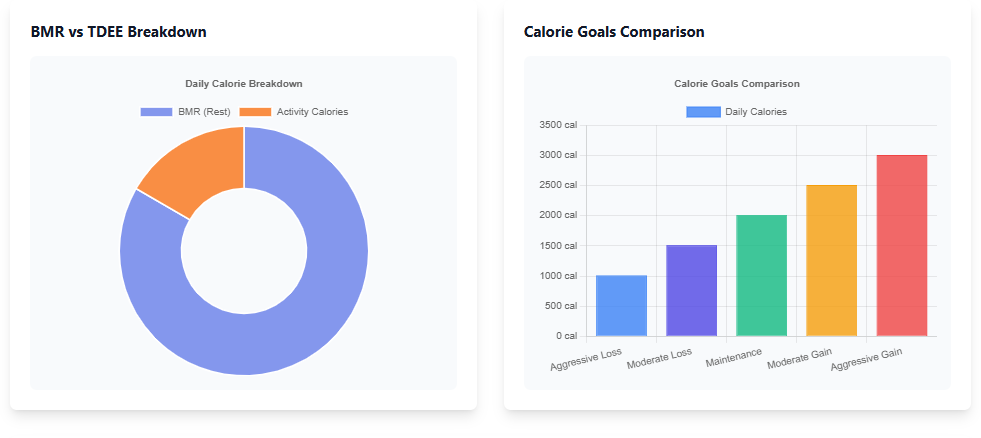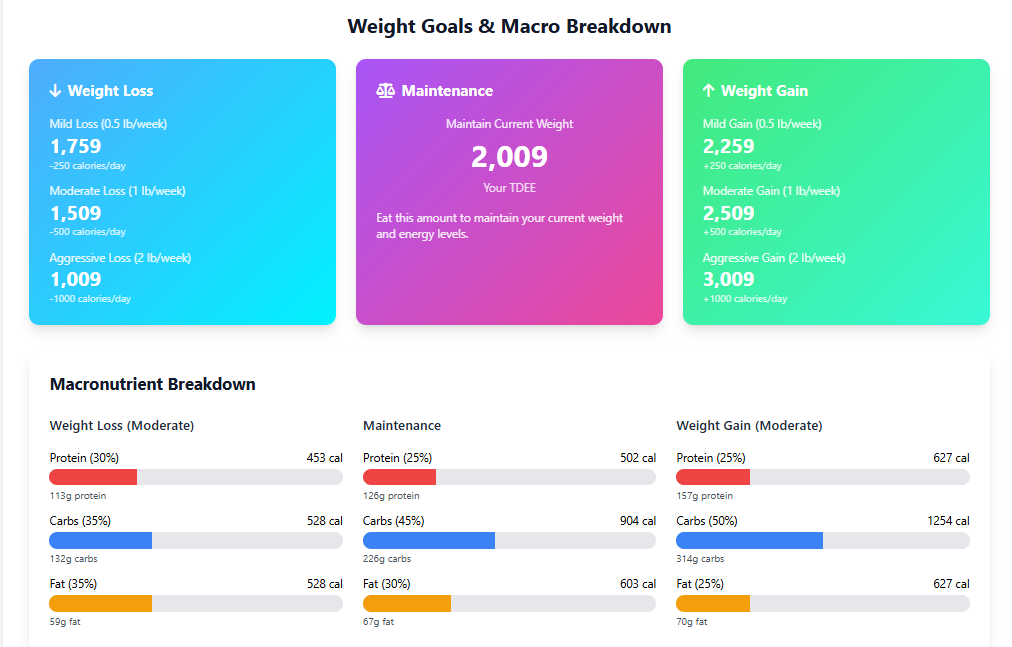BMR Decoded: Turn Your Resting Metabolism Into Real-World Results
Master your metabolism with our precision calculators and science-backed strategies

Your basal metabolic rate (BMR) is the engine idling beneath every choice you make. It's the energy your body needs at rest to keep you alive—breathing, circulating blood, regulating temperature, and running cellular maintenance. Where most plans fail is not in motivation, but in mismatched energy expectations. This guide shows you exactly how to use the result from our BMR Calculator to set calories, pick macros, and adjust targets over time. We'll connect BMR to your daily burn (TDEE), show how age, muscle mass, and hormones influence your metabolism, and walk through practical protocols for fat loss, recomposition, and muscle gain—using our Calorie Calculator, Macro Calculator, Body Fat Calculator, and BMI Calculator. Think of this as your metabolism playbook—clear, flexible, and grounded in measurement.
People Also Ask About BMR
How do I calculate my BMR?
The most accurate way is to use our BMR Calculator which uses the Mifflin-St Jeor equation (considered the most reliable). You'll need your age, gender, height, and weight. For even more precision, use our Body Fat Calculator first as formulas that include body fat percentage can be more accurate.
Which BMR is normal?
"Normal" BMR varies significantly based on age, gender, weight, and muscle mass. Most adult women have a BMR between 1,200-1,500 calories, while men typically range from 1,600-2,000 calories. Rather than comparing to others, focus on whether your BMR aligns with expectations for your specific stats using our BMR Calculator.
How much should I eat to lose weight if my BMR is 1400?
If your BMR is 1,400 calories, your Total Daily Energy Expenditure (TDEE) is higher when accounting for activity. Use our Calorie Calculator to determine your exact TDEE, then create a deficit of 300-500 calories daily for sustainable weight loss of 0.5-1kg per week.
Which BMR calculator is most accurate?
Our BMR Calculator uses the Mifflin-St Jeor equation, which is currently considered the most accurate for most people. For even greater precision, combine it with our Body Fat Calculator as formulas that incorporate body fat percentage can improve accuracy, especially for athletes and those with higher muscle mass.
BMR vs. TDEE: The Connection That Sets Your Calories
BMR is your minimum burn at rest. But your Total Daily Energy Expenditure (TDEE) adds everything on top—walking, training, digestion (TEF), even subconscious fidgeting (NEAT). That's why BMR alone isn't a calorie target; it's a starting value used to project TDEE and build a plan.

- BMR: Baseline energy needs at rest (no activity).
- NEAT: Non-exercise activity (steps, posture, chores) that quietly drives fat loss success.
- Exercise: Structured training that increases energy burn and shapes where weight changes occur.
- TEF: Thermic effect of food—protein especially increases energy spent on digestion.
- TDEE: Sum of the above—this is the number you eat around for goals.
Quick Workflow
- Calculate BMR → BMR Calculator.
- Estimate TDEE using activity level → Calorie Calculator.
- Set macros for your goal → Macro Calculator.
- Validate with body composition → Body Fat Calculator.
- Adjust every 4–6 weeks based on trend data.
Need a primer on BMI pros/cons? Check the advanced guide inside our BMI Calculator page and related Nutrition Guide.
What Changes Your BMR (and What Doesn't)
Metabolism isn't fixed. It responds to muscle mass, age, body size, climate, hormones, and energy availability. Understanding these levers keeps you from chasing myths and helps you choose changes that actually move the needle.
.png)
- Lean mass: More muscle increases resting burn. Progressive resistance training is a reliable long-term lever.
- Body size: Larger bodies have higher absolute BMR; weight loss reduces BMR over time (adaptive thermogenesis).
- Age: BMR tends to decline due to loss of lean mass and hormonal shifts—not age alone. Muscle retention offsets much of this.
- Hormones & medications: Thyroid, sex hormones, certain meds can tilt energy balance. Coordinate with your clinician if needed.
- Sleep & stress: They don't directly overhaul BMR, but they shift appetite, training quality, and NEAT—indirectly moving outcomes.
Myth Check
"I have a slow metabolism." Often, the issue is low NEAT, inconsistent sleep, or underestimating intake. Before assuming a metabolic problem, measure steps, log food honestly for 10–14 days, and compare outcomes to your calorie targets.
Choosing the Right BMR Formula (and Why the Tool Handles It)
There are multiple evidence-based equations (like Mifflin–St Jeor or Harris–Benedict) that estimate BMR from height, weight, age, and sex. Some athletes prefer formulas that include body fat percentage when available because they track lean mass more closely. You don't need to memorize the math—our BMR Calculator selects robust methods and pairs them with activity multipliers inside the Calorie Calculator, so your final targets land near reality faster.
From BMR to Goals: Deficit, Surplus, or Maintenance
Once you convert BMR to TDEE, you'll decide whether to eat at, below, or above that number. The right choice depends on your body composition, timeline, and training plan.
Fat Loss
Aim for a modest deficit (≈10–20% below TDEE). Larger deficits increase hunger and reduce training quality. Recalculate via the Calorie Calculator every time weight drops by 2–3 kg.
Maintenance
Eat near TDEE while building strength and skill. This is perfect for recomposition when paired with high protein and progressive resistance training.
Muscle Gain
Add a small surplus (≈5–12% above TDEE) and prioritize protein. Too large a surplus mostly adds fat. Use the Macro Calculator to distribute calories.

Protein & Macros: Building on Your BMR
Protein is the cornerstone for recovery and lean mass retention in a deficit. Carbohydrate supports training performance; fats support hormones and satiety. A simple starting point:
- Protein: Base on lean mass or body weight (the Macro Calculator will do this math).
- Carbs: Scale with training volume and intensity (more for endurance or high-volume lifting).
- Fats: Fill the remaining calories, maintaining a minimum for health.
If you're unsure where to begin, run the Body Fat Calculator to estimate lean mass, then use the Macro Calculator for a distribution tailored to your goals.
Adaptive Thermogenesis: Why Calories "Stop Working"
When you diet, your body quietly economizes. NEAT drops (fewer steps, less fidgeting), training intensity drifts down, and hunger signals rise. The result: the same calorie intake that worked last month may stop producing change. This isn't failure—just physiology. Countermeasures include:
- Tracking steps (8–12k/day is a practical anchor for many).
- Keeping protein high and distributing meals across the day.
- Scheduling small refeeds or diet breaks to reduce drive-to-eat.
- Rotating training emphases to keep intensity up without overuse.
Every 4–6 weeks, compare your weight/waist trends with projected changes. If progress stalls, revisit TDEE in the Calorie Calculator and refine macros with the Macro Calculator.
Example Protocols: Turn Numbers Into Practice
1) 8-Week Fat Loss Focus
- Set calories ≈ 15% below TDEE via the Calorie Calculator.
- Protein ≥ 1.6–2.2 g/kg; carbs aligned to training days; fats fill remainder (use the Macro Calculator).
- Training: 3–4 days resistance, 1–2 days cardio; keep steps ≥ 8k/day.
- Reassess body composition using the Body Fat Calculator every 4 weeks.
For meal structure templates, check our Nutrition Guide and Weight Loss Guide.
2) 12-Week Recomposition (Lose Fat, Build Muscle)
- Calories near TDEE (slight weekly undulation around maintenance).
- Protein high; nutrient timing supports lifts (carbs pre/post).
- Progressive resistance 3–5 days/week; track loads and reps.
- Monitor waist and strength PRs monthly. Adjust with the Calorie Calculator as lifts increase.
A "maintenance" phase is powerful when paired with intent—see the Fitness Guide for planning.
3) 16-Week Lean Bulk
- Calories ≈ 5–12% above TDEE; reassess monthly to limit fat gain.
- Protein robust; carbs emphasized on training days for volume.
- Focus on progressive overload, sleep, and meal consistency.
- Recompute BMR/TDEE in the BMR and Calorie calculators with each +2–3 kg milestone.
Use photos and waist to ensure the surplus is productive (muscle, not just scale weight).
Special Populations: Pregnancy, Adolescents, and Aging
Energy needs shift across life stages. Pre-pregnancy weight informs targets during pregnancy, but trimester-specific changes matter more once expecting—use the Pregnancy Calculator and see our Pregnancy Nutrition resource. Adolescents experience growth spurts and shifting appetites; prioritize quality foods, sleep, and supervised training habits rather than strict deficits. Older adults should focus on muscle retention via resistance training and protein distribution—BMR can be supported through lean mass, even if total calories are modest.
Troubleshooting: When the Numbers Don't Match Your Results
- Scale noise: Daily water and glycogen swings can mask progress. Look at weekly averages.
- Intake misestimation: Hidden liquids, cooking oils, and portions matter. Audit for 7–10 days.
- Low NEAT: Steps plummet under stress. Add short walks or movement snacks after meals.
- Sleep/stress: Poor recovery suppresses training output and increases hunger signals.
- Training mismatch: Volume or intensity too low to preserve/build muscle? Tweak the plan.
If you've truly adhered for 3–4 weeks and trends still disagree with projections, re-run your BMR and Calorie calculations with updated body weight and activity logs, then refine macros in the Macro Calculator.
Your Weekly Metabolism Dashboard
- Weight & BMI: Use weekly averages; check the BMI Calculator for context.
- Waist & Body Fat %: Reassess monthly via Body Fat Calculator.
- Calories & Macros: Validate intake with the Calorie and Macro tools.
- Steps & Training: 8–12k steps/day and progressive overload where appropriate.
- Sleep & Stress: 7–9 hours where possible; layer habits from the Fitness Guide.
Small weekly course corrections beat big restarts. Think "iterate," not "overhaul."
Further Reading & Interlinking (SEO)
For metabolism deep dives and practical scripts, see our dedicated article: BMR & Metabolism Guide. Pair it with the Nutrition Guide, Fitness Guide, and Weight Loss Guide. To connect your health metrics with broader planning, explore our Age Calculator (for lifespan milestones) and Time Calculator to schedule training microcycles.
Frequently Asked Questions
Is BMR my daily calorie target?
No. BMR is your resting baseline. Convert BMR to TDEE using activity factors inside the Calorie Calculator, then set a deficit, maintenance, or surplus depending on your goal.
How often should I recalculate BMR?
Recheck whenever your body weight changes by ~2–3 kg, your routine shifts (new job/training schedule), or at least every 8–12 weeks. Update calories via the Calorie Calculator.
Does building muscle raise BMR?
Yes—muscle is metabolically active tissue. Gains may be gradual, but consistent resistance training increases resting energy needs over time, especially when paired with adequate protein (plan with the Macro Calculator).
Why do two people with the same stats get different results?
Activity, NEAT, sleep, stress, hormones, and lean mass differ widely. Formulas estimate BMR; your tracked outcomes refine those estimates. Validate with monthly body fat checks and performance markers.
Can I use BMR during pregnancy or for adolescents?
You can estimate, but targets are different. Use the Pregnancy Calculator for trimester-specific needs and focus on quality foods and supervised guidance for adolescents.
Calculate Your BMR—Then Build a Plan That Works
Translate resting metabolism into calories, macros, and measurable progress.
Keep learning: BMR & Metabolism Guide • Nutrition Guide • Fitness Guide